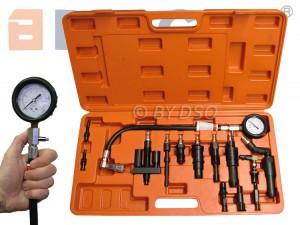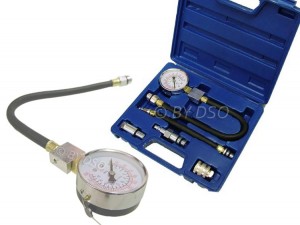 The compression of your car’s engine is a very important characteristic for proper functioning. Poorly sealed cylinders can lead to serious issues that may eventually result in the rebuilding of the engine. Checking the engine’s compression involves an instrument called compression tester.
The compression of your car’s engine is a very important characteristic for proper functioning. Poorly sealed cylinders can lead to serious issues that may eventually result in the rebuilding of the engine. Checking the engine’s compression involves an instrument called compression tester.
What is a Compression Tester?
The compression tester checks the valve and rings of the engine and it detects excessive carbon. There are two varieties on the market.
The threaded screw tester is screwed into the spark plug opening.
Alternatively, you can use a hand-held compression tester. If you choose this possibility, you will have to work with another person. Your helper will have to crank the engine while you are performing the test.
The traditional compression tester consists of an indicator dial gauge, a testing tube and a spark plug holder or a rubber tip in the case of a hand-held piece.
According to professionals, threaded screw compression testers provide more accurate readings.
How to Check the Engine’s Compression
The engine manufacturer will provide you with the correct compression reading. You should use it as a guideline while performing the test. Keep in mind there could be variations in compression engine readings recommended by different manufacturers.
You first need to remove the spark plug from the engine cylinder you are about to test. Never attempt removing a spark plug at working temperature because it will lead to severe burns. Locate the distributor cap and pull the centre coil wire. By doing this, you will be preventing the engine from starting but still building compression to perform the test.
Get your spark plug compression tester. Install it in the hole of the spark plug. Hand tightening is usually sufficient to position the tester accurately. Hand-held testers have a rubber tip that has to be pushed into place.
Crank the engine and take the compression tester’s measure. For best results, perform the test a couple of times and calculate the average or choose the test reading that appears most often. Use the manufacturer-supplied information to compare the results.
Press the release valve to release the compression from your car’s engine. You are done! After you are done testing and reinstalling spark plugs, run the engine to make sure that everything functions properly.
 A Few Additional Tips and Considerations
A Few Additional Tips and Considerations
If you own a hand-held compression tester, you may be interested in creating a better seal for more accurate readings. Grease can be used to achieve that goal. Just use your finger to apply a little bit of grease on the rubber tip.
There could be specific compression testing procedures for particular engine models. It may be a good idea to familiarise yourself with the process before getting started. Manufacturers may suggest different methods of creating engine pressure, so make sure that you are informed.
Checking the engine compression is a simple, yet highly beneficial procedure. Every vehicle owner should have a compression tester. Perform the test whenever you experience any problem like the loss of too much oil or a general lack of engine power. Compression testing will help you figure out what the cause of the problem is.
Author – Tony Heywood

Tony Heywood is a ‘Retail Troubleshooter’ with 40 years experience in the retail industry, specialising in e-commerce over the last decade. He has his own consultancy firm and is MD of ’e sell it’, an on-line store selling tools and auto-care products worldwide.
For tools & auto-care products at trade prices, please visit: www.esellit.com
Or call: 020 8201 0588